And that frustration is what led to the concept of a plungerless small square baler on the shop floor of a Bloomfield, New York, farm.
Several years ago, John Randall, a hay farmer in Bloomfield, visited a Freeman manufacturing plant where an engineer mentioned they were thinking about making a double baler by forming a bale twice as wide as a normal bale with four strings on it and pushing it through a knife to cut it in two. Randall was hopeful it would be developed as it could see a savings in field time. However, Allied bought Freeman and apparently decided not to develop the project.
One of the limiting factors of current small bale balers is: A knot can only tie “just so fast” (about two-thirds of a second), and that becomes a mechanical limit. Randall says another limiting factor has to do with plunger strokes. “You can go 100 strokes a minute,” he says, “or up to 120 strokes, but it’s a shorter stroke. On a big square baler, 45 to 50 is all you can do because of the mass of the plunger. Because the plunger is reversing at the front to go back and is reversing at the back to go forward, it becomes impossible to build a bigger, faster baler. It’s just the physics of it. They’ve reached the physical limit of what they can do with these things.”
Moreover, Randall says, the plunger is only compressing the hay 25 percent of the time at best.
Randall discussed the idea with John Russell (from Pemberville, Ohio) and a few other producers who like developing equipment ideas, and Randall was interested in working on the double baler idea. However, he says, “One night it came to me we were going to be making a 35-inch bale and cutting it in two. While 35 inches is the length we want, why can’t we pull the knotter out of the baler, and have it go crossways, and get the exact length we want? That would eliminate one of the key problems of capacity.”
“Turning the bale sideways solved the knotter and plunger timing problem and the bale length problem,” Randall says. “However, once the knotter is removed from the chamber, and the bale width can be cut ‘on the fly,’ that allows for continuous compressing of the hay, and one of the things I remember from college is: Continuous flow is always more efficient than batch processing. Then I had the idea of compressing hay by forcing it through a funnel of some sort.”
Randall figured if he could tie the bale crosswise instead of lengthwise, it would free up capacity and reduce the mechanical limits on current balers. His idea temporarily bogged down when he realized he would be tying the bale on the uncompressed side and it wouldn’t hold together without compression, which the plunger usually provides.
Then he “dreamed up” the concept of a plungerless baler – a design that would compress bales without a plunger. He worked slowly on the idea for three years. Although he had the concept, he still had to figure how to build it – more than just visualize it.
That meant learning how to run a 3D CAD program in order to design the machine. He had hoped to be able to animate the CAD model but found that was beyond his capabilities. He also realized an animation would not prove the idea worked, so he designed what he hoped would be a one-third-size scale working model. Then he had to figure out how to make each part.
In the winter of 2016-2017, he started building a scale model to see whether the idea of a plungerless baler was even possible.
The design (Figure 1) includes a pickup that feeds a V-shaped chamber.

The chamber has chain-driven rollers on top and bottom, and the sides of the chamber have chain-driven steel slats that move in the same direction as the rollers to feed the hay from the wide end and slowly compress it until it leaves the bottom of the V in exactly the bale length desired. Randall is convinced it will work, as all four sides are moving with each other to compress the bale and move it rearward.
“What I’m doing,” Randall says, “is slowly but steadily compressing the hay and, when it’s released out of the last rollers, it’s going to expand, so it’s a matter of designing the chute or containment area so it expands as much as you’re going to let it, but it would still slide through the chute.”
The first chute he made was too small and ended up as scrap metal in the trash bin. When he enlarged the chute, the rollers were able to push out the compressed bale without a problem. The bale would be cut to width and tied as it comes out of the chamber and, although the slicer hasn’t been designed yet, Randall believes that will be the easy part.
Of this new concept, he says essentially, “It’s like making sausage, and it should be fast. With enough horsepower, and built strong enough, the limiting factor should be the bale-sizing cutter. If the cutter could cut one bale per second, this baler would have the capacity of 10 current small square balers.”
The one-third scale model Randall built still has some issues he’s trying to iron out, and some unknowns remain. For instance, since Randall isn’t an engineer by trade, understanding the strength of different materials has taken some time (and expense) to figure out. “And then you take it out to use it,” he says, “and find it’s all wrong and breaks anyway.”
Randall says, in his model, the pickup is feeding the hay into the chamber too fast, too aggressively. It’s one point that needs refinement.
He also doesn’t know yet whether different hay materials would require different-sized chambers – will timothy and orchardgrass expand at different rates? Will straw expand differently?
Another hurdle that would have to be crossed in time would be customer acceptance of a bale that looks different. Horse customers are used to feeding their animals “by the flake,” and flakes are created by plungers.
Although Randall says it’s easy enough to develop knives to “slice” flakes into the hay as it comes out, some marketing would have to be addressed to get customers to accept the look of the new bale. Randall says, “When I ran it, I discovered that unless somebody makes a big mess of the hay in the field, the stems generally lie in the direction of travel, and if you feed them through the baler that way, I think the bales are just going to fall apart. I’m not sure we’ll need to slice them.”
Last fall, he took the advice of one of the National Hay Association members and started wrapping the “sausage” with stretch-wrap. He says that was a huge improvement, “simple to do, continuous, and it eliminates all the little fail-able parts of a knotter or strapper, and it’s weather-proof like a round bale.” (The cutter is the only part of the baler that has reciprocating parts; everything else is continuous.)
But it still needs more refinement. “This is still really just a proof-of-concept model, and who knows what all the problems are going to be,” Randall says. “I don’t think 10,000 dollars would cover what you see sitting there on that table – materials and machine time I had hired out. None of that includes my time. It’s an expensive toy, but compared to a snowmobile, it’s cheap and a lot more fun.”
His goal is to have a working model. “I think it will work,” he says, “but it’s a long way from a production model or field model.” Randall says if he was 20 or 30 years younger, he’d keep working on it until he had a field-ready model just to help his operation, but he also realizes it’s still going to take a large amount of money to get a salable design.
It’s not likely, Randall says, that original equipment manufacturers of hay equipment will spend more time on small baler development. New Holland, for instance, reported small square balers make up roughly 17 to 21 percent of total baler sales (when considering round balers, small and large square baler sales).
Randall is convinced his idea deserves more eyes looking at it and some rigorous engineering and testing. He already has a list of changes he’d like to try just from the limited use of the scale model.
One challenge inherent to any new development is funding. And another, perhaps even more important, is finding believers in the concept of a novel design for hay balers. It’s not digital. It’s not a huge market, but there are new hay balers sold every day all over the world.
Randall struggles with knowing how to find the “right” people and knowing what to do next. What he does know is: A producer who is producing a quantity of hay can’t continue to produce 30-pound bales at 100 bales an hour and meet demand. ![]()
PHOTO: John Randall discusses design concepts of a plungerless baler to a group of fellow hay producers. Photo by Lynn Jaynes.
John Randall is a member of the National Hay Association.
Click here to read more about his multiple baler modifications.
To see more photos of Randall’s equipment, view the slideshow.

-
Lynn Jaynes
- Editor
- Progressive Dairyman
- Email Lynn Jaynes












